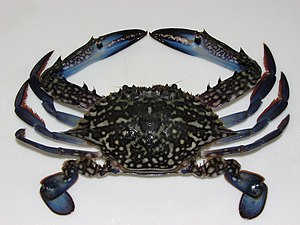Great Pacific swimming crab
| Great Pacific swimming crab | ||||||||||||
|---|---|---|---|---|---|---|---|---|---|---|---|---|

Great Pacific swimming crab (male) |
||||||||||||
| Systematics | ||||||||||||
|
||||||||||||
| Scientific name | ||||||||||||
| Portunus pelagicus | ||||||||||||
| ( Linnaeus , 1758) |
The great Pacific swimming crab ( Portunus pelagicus ) is a large species of crab from the swimming crab family that is found in the intertidal zones of the Indo-Pacific . The Indonesian common name is Rajungan and in the Philippines the species is called Alimasag .

features
The shell is coarse to grainy with distinct areas. The front surface (between the two eyes) has four pointed triangular teeth. There are nine teeth on the front and side edges. The outermost tooth is two to four times larger than the teeth next to it. The scissors are elongated (more in males than females) with a conical tooth at the base of the fingers. There are three thorns on the inner edge of the merus. The legs are flattened laterally to varying degrees, the last two segments of the last pair are paddle-like. The carapace of the male is light blue with white spots, the females are pale green. The tank has a width of up to 20 centimeters.
Systematics
Portunus pelagicus originally consisted of a species complex whose range stretched from the Mediterranean Sea, the Red Sea, the Persian Gulf, East and South Africa, the Indian Ocean to the Indo-Pacific waters of Indonesia, the Philippines, Australia and eastward to New Caledonia . A revision from 2010 came to the conclusion that this complex consists of four morphologically different, geographically delimited species. The distribution area of Portunus segnis extends in the western Indian Ocean and the Mediterranean Sea, in South Africa, East Africa, in the Red Sea, Gulf of Aden, Socotra, South Man, in the Persian Gulf, Gulf of Oman, Pakistan and west of the Indian subcontinent. Portunus pelagicus sensu stricto occurs in the western Pacific, from Japan to Indonesia, from the Strait of Malacca to Thailand and in the Australian Northern Territory. Portunus reticulatus occurs in the eastern Indian Ocean, east of the Indian subcontinent, Sri Lanka and in the Bay of Bengal . Portunus armatus is restricted to Australian waters as far as New Caledonia.
Way of life and ecology
The crabs remain buried under sand or in mud most of the time, especially during the day and in winter, which explains their high tolerance to ammonium (NH 4 + ) and ammonia (NH 3 ). At high tide they come out and look for food. They feed on various organisms such as mussels, fish and, to a lesser extent, macroalgae. Their flattened legs, reminiscent of paddles, make them excellent swimming. However, unlike the species of crab Scylla serrata , they cannot survive outside of the water for long.
The great Pacific swimming crab often makes its way into the estuaries to find food and shelter. Their life cycle depends on the estuaries, as the larvae and young crabs use these habitats for growth and development. During the breeding season, the female moves into shallow marine habitats, spawns and the hatched zoo larvae migrate to the estuaries. During this time they feed on microscopic plankton and develop from the Zoea I stage to the Zoea IV stage in about eight days . After another four to six days they reach the last larval stage, the megalopa, where the Chelidae form. Even after the transition from the planktonic way of life of the zoea to the bottom life of the finished crab, the young crabs remain for some time in the estuaries, which offer them protection and food.
Commercial catch
This species is commercially important throughout the Indo-Pacific, where it is offered as a traditionally hard-shelled or soft-shelled crab. It is considered a delicacy throughout Asia . The species is valued because the meat is almost as sweet as that of the blue crab ( Callinectes sapidus ). The fast growth, the easy larval rearing, the high fertility and the relatively high tolerance to nitrate and ammonia (especially ammonia nitrogen (NH 3 –N), which is typically more toxic than ammonium because it can more easily escape through the gill membranes) make this species ideal for aquaculture .
The species is fished commercially in Australia, but is also available to recreational anglers and the catch is regulated by various state governments.
literature
- Peter KL Ng: Crabs. In: Kent E. Carpenter & Volker H. Niem (eds.). FAO Species Identification Guide: The Living Marine Resources of The Western Pacific. Vol. 2, Food and Agriculture Organization, Rome, 1998, p. 1124.
- Joelle CY Lai, Peter KL Ng, Peter JF Davie: A revision of the Portunus pelagicus (Linnaeus, 1758) species complex (Crustacea: Brachyura: Portunidae), with the recognition of four species. ( PDF , 2 MB) The Raffles Bulletin of Zoology. 58 (2), 2010, pp. 199-237. ISSN 0217-2445
Web links
- Species Fact Sheet at the FAO
- Species Fact Sheet at Sealifebase
- Marine Species Identification Portal: Crabs of Japan
- Fisheries Western Australia - Blue Swimmer Crab Fact Sheet
- Flower crabs, Portunus pelagicus . In: Online guide to Check Jawa . wildsingapore.com. 2003.
- Leo WH Tan & Peter KL Ng: Flower crabs, Portunus pelagicus . In: Seashore Life in Singapore . 1988.
Individual evidence
- ↑ Joelle CY Lai, Peter KL Ng, Peter JF Davie: A revision of the Portunus pelagicus (Linnaeus, 1758) species complex (Crustacea: Brachyura: Portunidae), with the recognition of four species. The Raffles Bulletin of Zoology. 58 (2), 2010, pp. 199-237. ISSN 0217-2445